Supercharge Advertising Impact With Emotion-Based Brand Building Creative Campaigns
Click here to view a 10-minute video of the key findings.
You are writing advertising copy for your store or brand. Or, you are writing copy to promote a podcast or AM/FM radio station. You include features, benefits, and the attributes of your brand. This is the rational approach and it tries “to prove the product’s quality and usefulness by listing the product’s benefits, or quoting facts or statistics.”
There is a second approach – emotion-based marketing. “Emotive marketing instead appeals directly to a consumer’s emotional state, needs, and aspirations.” Emotion-based ads can also be funny and entertaining.
How advertising works
Les Binet, the Head of Effectiveness at adam&eve DDB London and lead of DDB Matrix, the network’s econometrics consultancy, is one of the two “godfathers of marketing effectiveness.” The other “godfather” is marketing consultant Peter Field. Binet and Field are prolific on the topic of marketing strategy and advertising impact.
According to Binet,
- “Advertising increases/maintains sales and margins
- by slightly increasing chance that people will choose your brand
- by making the brand easy to think of and easy to buy
- and creating positive feelings and associations
- via broad reach ads that people find interesting and enjoyable
- and targeted activation that they find relevant and useful.”
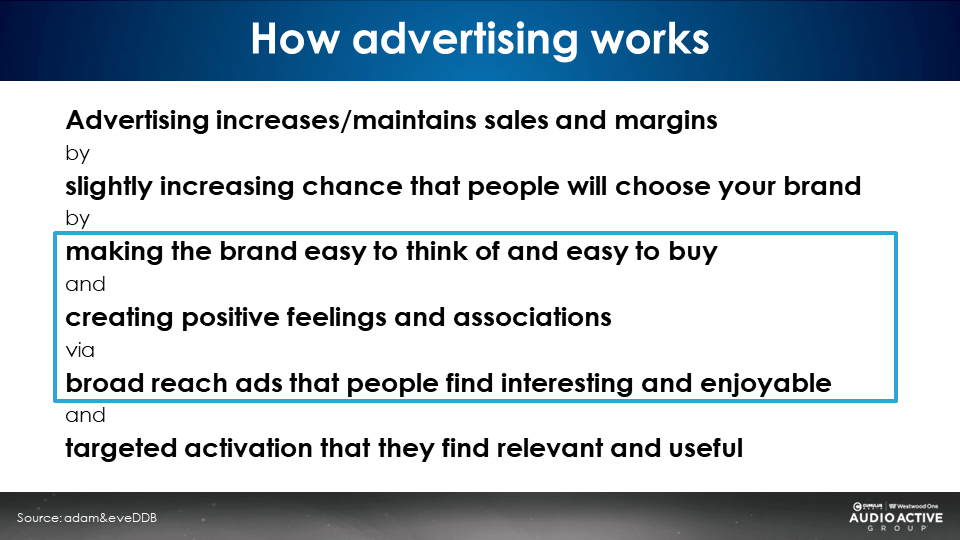
The rational approach to advertising (relevant and useful targeted activation) works together with the emotion-based approach that “creates positive feelings and associations” via broad reach ads that are “interesting and enjoyable.”
Les Binet: “Emotion is the most powerful selling tool we have”
Binet states:
“The process of building a brand, which is ultimately about preparing someone to buy your product at some point in the future, takes a very long time. When somebody buys a car, that process of making the decision starts maybe 10 or 20 years before they actually come to buy it. Even the process of selecting a chocolate bar, as I did earlier on, that decision has been brewing in my mind ever since I was in school.
In order to really build strong brands, you’ve got to start preparing consumers long before they even start thinking about the product or the purchase. That means engaging them when they’re not interested in what you have to say, when they are not thinking about the product, when they have no need to be satisfied. So you can only do that by engaging them with things that are intrinsically interesting at a human level and that will be remembered for a very long time.
So emotion is the most powerful selling tool we have. And therefore, emotional media are much more powerful for building brands and generating profit.”
Audio trumps video in creating consumer engagement with emotion-based stories: Game of Thrones audio book beats the TV show in consumer engagement
Consumers are far more engaged with an audio story than a video narrative. For example, the Game of Thrones audio book audience showed greater physiological responses (heart rate, body temperature, and galvanic skin response) than viewers of the TV show.
The authors report:
“Physiological responses revealed more cognitive and emotional engagement while listening to audio narratives. … spoken narratives require the participant to be an actively engaged listener, whereas videos deliver rich stimulation to a more passive viewer. The pictures in the listener’s mind [from the audio narrative] may not be as vivid and as detailed as those onscreen … yet the imaginative generation of those images requires greater cognitive and emotional processing, and so they are physiologically more engaging.”
Audio narratives require active participation to imagine the story. Video narratives require less of the audience, resulting in passive engagement. Thus the “sight, sound, and motion” ideal that brands seek actually results in less engagement than the same ad on a podcast or AM/FM radio.
Emotion-based creative builds stronger brands and generates greater business outcomes
Binet and Field have studied thousands of campaigns and found that emotion-based advertising generates stronger brand equity compared to rational creative.
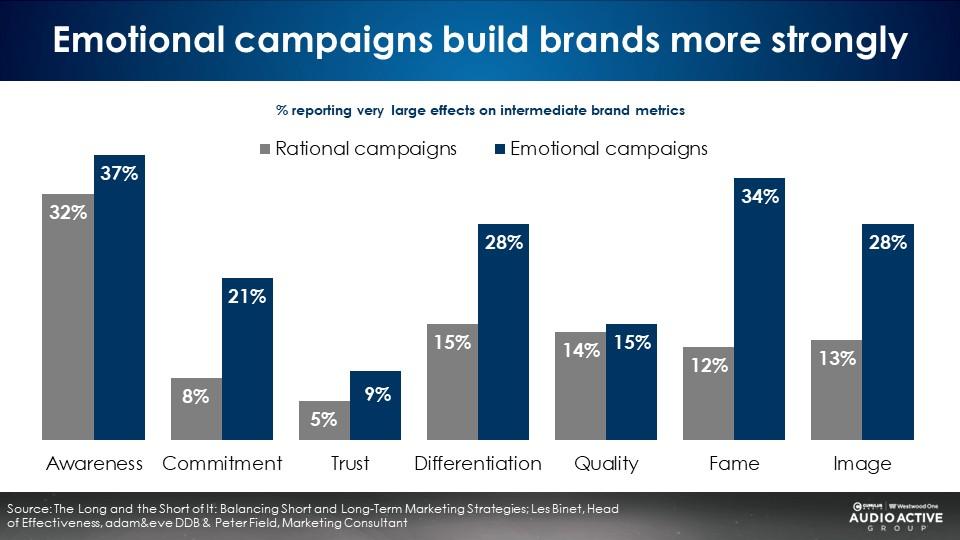
Binet and Field’s research finds that this stronger brand equity leads to better business outcomes.
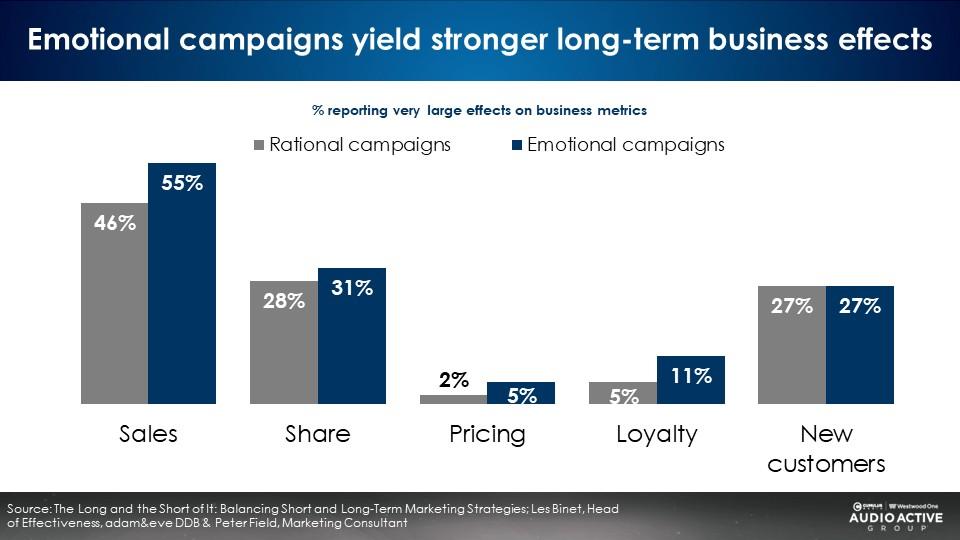
Design marketing for System 1 thinking
“Princeton University psychologist Daniel Kahneman, PhD, was awarded the Nobel Memorial Prize in Economic Sciences for his groundbreaking work in applying psychological insights to economic theory, particularly in the areas of judgment and decision-making under uncertainty.” His bestselling book, Thinking, Fast and Slow, highlights two different ways of thinking.
“System 1: the vast majority of our decisions are quick and instinctive, and driven by emotion and experience. System 1 simplifies decisions and allows judgments to be made more quickly and easily. System 1 underpins every decision we ever make – you can’t switch it off.
System 2: decisions are difficult and considered, occurs when we have to process complex or ambiguous information. If we can avoid this difficult decision making, we will.”
Emotions guide and simplify our decision making: Positive emotional responses lead to a positive evaluation of choice
In their book System1: Unlocking Profitable Growth, authors John Kearon, Orlando Wood, and Tom Ewing indicate, “System 1 is so effective in simplifying decisions that no great consideration is needed. Kahneman calls System 2 the ‘lazy policeman’ – it monitors System 1 decisions and has the authority to intervene, but seldom does because it is effortful to do so.”
Kearon, Wood, and Ewing say that of the seven emotions identified by psychologist Paul Ekman, only one, happiness, is truly positive. (The seven emotions are happiness, surprise, sadness, anger, fear, disgust, and contempt.) “If something makes us feel happy, our System 1 decides it’s probably a good option.”
So the features and benefits are generally not really considered. If your product or service conjures up a positive emotional response, it is probably a good option.
Build familiarity, create positive emotion, and make things easy to process
Kearon, Wood and Ewing espouse the “3 Fs”:
“Achieve Fame, Feeling and Fluency. The 3 Fs drive profitable brand growth. Brands should come readily to mind (Fame), feel-good (Feeling), and be recognizable (Fluency).
Fame is what gets a brand into a person’s mental shortlist. The more readily a brand comes to mind in a decision context, the better the choice our System 1 assumes it to be. To build fame, target wide, touch deeply, and be distinctive.
Fluency is the speed and ease of processing information. Fluency is the strength of a brand’s distinctiveness. If a brand is easily recognized and processed, it must be a good choice. This hands a huge advantage to brands with distinctive logos, slogans, jingles, color schemes, music or other unique assets.
Feeling positive emotion is the driving force behind profitable advertising. Advertising helps us feel good about a brand – and if a brand feels good to our System 1 minds, it’s a good choice.”
Podcast listeners prefer funny and entertaining ads but say they are more likely to hear rational podcast ads that communicate features/benefits
Cumulus Media and Signal Hill Insights’ Podcast Download – Spring 2022 Report finds funny and entertaining ads are preferred among podcast consumers. However, listeners most often hear rational “feature and benefits” ads.
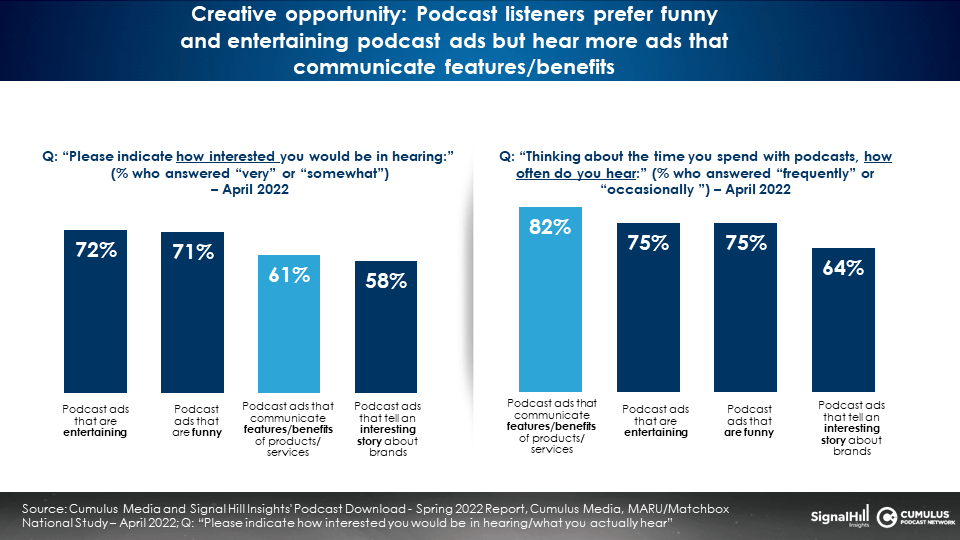
In Paul Feldwick’s book Why Does The Pedlar Sing? What Creativity Really Means In Advertising, he says, “Advertising is at least as much showmanship as it is salesmanship [and it] builds brands best when it is entertaining, popular and memorable, when it is not just a pitch, but a performance.” The podcast audience is pleading for a greater focus on advertising creativity and showmanship.
Maya Angelou: “People will never forget how you made them feel”
Feature/benefits copy will be forgotten but generating positive feelings and emotions about a brand is long lasting. Consider Maya Angelou’s famous quote, “I’ve learned that people will forget what you said, people will forget what you did, but people will never forget how you made them feel.”
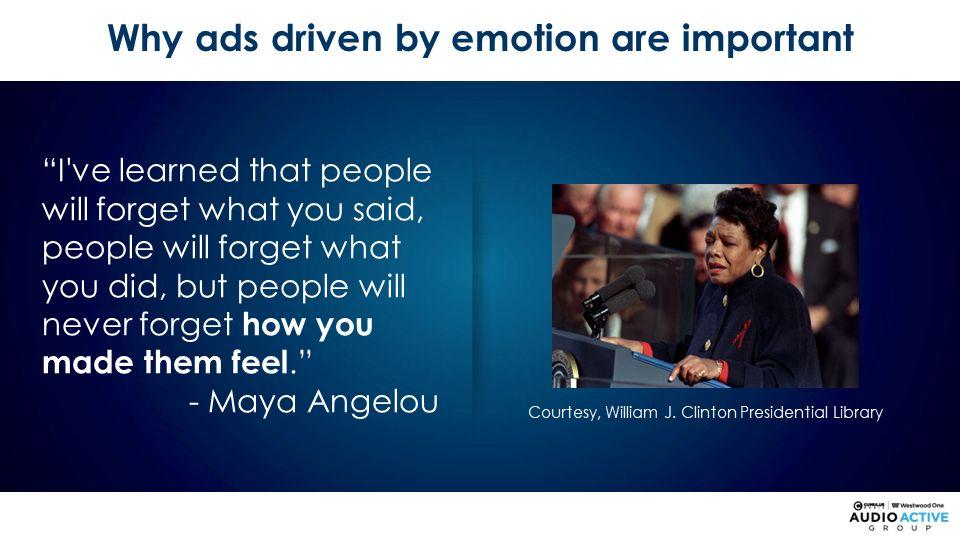
Grainger: A business-to-business brand whose audio creative does an outstanding job with an emotion-based creative approach
Grainger is a firm that provides all manner of supplies and items for facilities managers who oversee the safety and smooth operation of factories, buildings, and facilities like sports stadiums. Instead of the classic B2B creative approach of facts, figures, features, and benefits, Grainger’s audio ads make their customer the heroes who keep their facilities humming and workers and visitors safe. Grainger has a melodic sonic logo and a wonderful slogan, “For the ones who get it done.”
Listen to a few examples:
The next time you find yourself writing advertising copy or promos for a podcast or AM/FM radio station, consider the power of emotion-based brand building. As Les Binet says, “Emotion is the most powerful selling tool we have.”
Key takeaways:
- According to Binet and Field, the rational approach to advertising (relevant and useful targeted activation) works together with the emotion-based approach that “creates positive feelings and associations” via broad reach ads that are “interesting and enjoyable.”
- Emotion-based creative builds stronger brands and generates greater business outcomes.
- Scientific studies of consumer response reveal greater engagement with audio narratives versus video storytelling.
- Emotions guide and simplify our decision making: Positive emotional responses lead to a positive evaluation of choice.
- According to authors John Kearon, Orlando Wood, and Tom Ewing, ads should build familiarity, create positive emotion, and make things easy to process.
- Podcast listeners prefer funny and entertaining ads but say they are more likely to hear rational podcast ads that communicate features/benefits.
- Grainger is a business-to-business brand whose audio creative does an outstanding job with an emotion-based creative approach in their “The ones who get it done” campaign.
Click here to view a 10-minute video of the key findings.
Pierre Bouvard is Chief Insights Officer of the Cumulus Media | Westwood One Audio Active Group®.
Contact the Insights team at CorpMarketing@westwoodone.com.